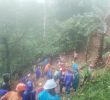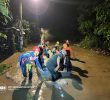
This vast rice field in Barangay New Rizal, M’lang, North Cotabato shows cracked land due to severe drought. (Ace R. Morandante/davaotoday.com file photo)
TAGUM CITY — The provincial government is set to declare Davao del Norte under a state of calamity due to the havoc caused by the intense dry spell.
The Provincial Disaster Risk Reduction and Management Council (PDRRMC) approved on Wednesday, May 25 a resolution recommending the declaration to the Sangguniang Panlalawigan (SP) due to intense drought since January.
Romulo Tagalo, executive-director of the PDRRM Council, told Davao Today that the decision to declare the province under state of calamity rests upon the Sangguniang Panlalawigan. He added that the merits of the resolution will be discussed on Monday, May 30.
Invoking Republic Act No. 8185, Tagalo said the council pushed such measure following the declaration of state of calamity by the local government units of Kapalong, Asuncion and Carmen, after sustaining the brunt of the water scarcity.
The council proposed a budget intervention of P11 million “to combat the adverse effect” of the dry spell. PDRMMC said the amount “will be earmarked for seed assistance, fertilizer assistance, fingerlings, medicines and relief goods.”
The council also approved the 2017 Local Disaster Risk Reduction and Management Fund amounting to 73,335,575.
Provincial Agriculturist Dr. Anastacia Notarte said the dry spell damaged some 36,449.45 hectares of agricultural land in the province. She said the banana sector has suffered the impact of the calamity, affecting 13,828 hectares valued at P408.6 million.
Some 6,809 hectares of rice were also damaged amounting to P202.8 million, together with hundreds of millions worth of corn, coconut, vegetables and fisheries, Notarte added.
Davao del Norte Governor Rodolfo del Rosario stressed the urgency of passing the resolution after the El Niño damaged P883,5-million worth of crops and affected 57,244 families around the province.
Meanwhile, the Provincial Health Office also recorded 7,593 cases of morbidity related to the effects of the El Niño. Upper respiratory tract infections comprised the bulk of the illnesses, reaching 3,057 cases, which also saw the rise of diarrhea, skin infection, chicken pox, mumps and amoebiasis. (davaotoday.com)










